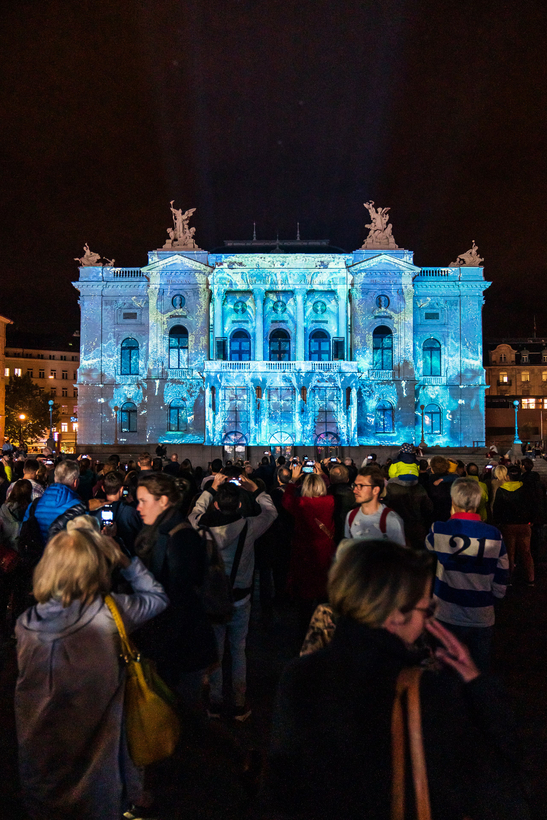With its pediments, fluted columns, and rampant angels spreading their wings above portrait busts of great composers, the neoclassical façade of the Zurich Opera House is anything but a tabula rasa. Yet this is the screen onto which Projektil, a Swiss producer of immersive light shows, has mapped four state-of-the-art animations on themes from Richard Wagner’s “Ring” cycle. Water spirits, dragons, gods, heroes, and giants appear and vanish like figures in a living tapestry. Savage beasts chase their prey though the dense forest. Spears hang in air as landscapes whiz by. Rings of water, rings of fire, the fateful gold itself—all glow in the night in hues of molten gemstones. Sometimes the architecture disappears, sometimes it’s thrown into relief as by a wizard’s wand.
If you know your “Ring,” you’ll follow Projektil’s addictive Lichtspektakel the way the faithful once would “read” Bible stories in the mosaics or frescoes of Renaissance cathedrals. If not, they just might be the gateway to Wagner you’ve spent a lifetime waiting for: mysterious yet infinitely suggestive. Alternatively, simply bliss out on the head trip. Wisely, the creative team has stitched the soundtracks together from instrumental passages in the cycle, strictly excluding all vocals. Everybody loves the Ride of the Valkyries, but junior Brünnhildes cutting loose with their Hojotoho!s might send newbies scrambling for the hills.

Viewers in Zurich have been experiencing all the son et lumière in tandem with the 18-month rollout of the Zurich Opera’s new production of the “Ring,” staged by the company’s general manager Andreas Homoki. Artistically, the two treatments have zero in common. As a theater artist of his time, Homoki freely time-and-space-shifts the action to realms of his own devising: his Wotan is said to resemble a banker, the Rhine Maidens are dead ringers for Marilyn Monroe. The Projektil team’s point of reference is Wagner’s traditional Old Norse iconography, filtered through vintage stage design, fantasy anime, and graphic novels.
As Homoki explains in a mini-documentary (in German, unfortunately unsubtitled), the company felt honor bound to share the “Ring” with the whole city, not just the base. After all, it was here in Zurich that Wagner developed the idea for his epic, wrote the libretti, and composed two-thirds of the music. So much for the hegemony of Bayreuth and its purpose-built Festspielhaus, the shrine where the Master unveiled the “Ring” in its totality in 1876.
For the Full Projektil Monty, you’ll have to go to Zurich, and what you see on your computer screen may tempt you to hop a plane. If so, mark your calendar now. At this point, Parts 1 through 3 are available online. Homoki’s “Ring” concludes with Götterdämmerung on November 5, preceded by three nights of the integral 40-minute Lichtspektakel on the Opera House façade.
Links to the light shows may be found on the Opernhaus Zürich Web-site or on YouTube
Matthew Gurewitsch writes about opera and classical music for AIR MAIL.He lives in Hawaii

